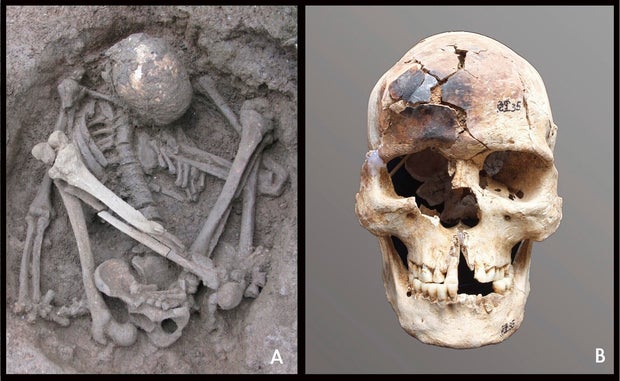Scientists have discovered what’s thought to be the oldest known mummies in the world in southeastern Asia dating back up to 12,000 years.
Mummification prevents decay by preserving dead bodies. The process can happen naturally in places like the sands of Chile’s Atacama Desert or the bogs of Ireland where conditions can fend off decomposition. Humans across various cultures also mummified their ancestors through embalming to honor them or send their souls to the afterlife.
Egypt’s mummies may be the most well-known, but until now some of the oldest mummies were prepared by a fishing people called the Chinchorro about 7,000 years ago in what’s now Peru and Chile.
A new study published Monday in the journal Proceedings of the National Academy of Sciences pushes that timeline back.
Hirofumi Matsumura / AP
Researchers found human remains that were buried in crouched or squatted positions with some cuts and burn marks in various archaeological sites across China and Vietnam and to a lesser extent, from the Philippines, Laos, Thailand, Malaysia and Indonesia.
Studying the bones further, scientists discovered the bodies were likely exposed to heat. That suggested the bodies had been smoke-dried over a fire and mummified by hunter-gatherer communities in the area.
The practice “allowed people to sustain physical and spiritual connections with their ancestors, bridging time and memory,” study author Hirofumi Matsumura with Sapporo Medical University in Japan said in an email.
The results were “a great surprise,” said Hsiao-chun Hung, senior research fellow at Australian National University.
“The bones are so ancient, and it is remarkable to discover that this tradition is so old, connecting the practices of ancient peoples with those still found in some communities today,” Hung said.
The process allowed relatives to maintain contact with the deceased, and in some cases was believed to allow the spirit to roam freely during the day and return to a body at night.
“I believe this reflects something deeply human — the timeless wish that our loved ones might never leave us, but remain by our side forever,” Hung told Agence France-Presse.
The researchers theorize that the practice may have been common in ancient Asian civilizations.
“This tradition may have been known among hunter-gatherer societies across a vast region, for many millennia,” they wrote in the study,
Li Zhen and Hirofumi Matsumuravia via AP
Dating methods used on the mummies could have been more robust and it’s not yet clear that mummies were consistently smoke-dried across all these locations in southeastern Asia, said human evolution expert Rita Peyroteo Stjerna with Uppsala University in Sweden, who was not involved with the research.
The findings offer “an important contribution to the study of prehistoric funerary practices,” she said in an email.
Mummies are far from a thing of the past. Even today, Indigenous communities in Australia and Papua New Guinea smoke-dry and mummify their dead, scientists said.
Agence France-Presse contributed to this report.

